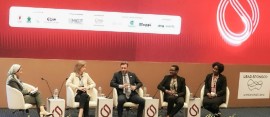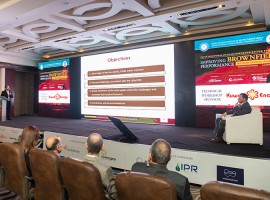Embracing foreign investments in oil&gas industry under modernization scheme.
By Salma Essam, Nataša Kubíková
Following a period of economic and political restructuring, Egypt’s oil and gas industry has stabilized relative to where it was. The Egyptian government is taking huge steps to bring in more foreign investments predominantly, but not exclusively, in the upstream sector, as further discoveries are being made. The buzz word is a safer investment climate for exploration and production, which is in line with the Oil Ministry’s new Modernization Program.
The 1st Initiative of the Modernization Program – Investment Attraction – takes upon itself to create safe and appealing investment environment and lure in international oil companies’ (IOCs) capital. This initiative is a cornerstone of future progress and tackles the challenges of production-sharing agreements as well as structures and processes of operations in Egypt for foreign companies.
It is a truth acknowledged that the decline in investment in Egypt, following the events of 2011, was not solely due to the state of political unrest. The global prices of oil that fell in mid-2014 were clearly a decisive factor in the game. Diaa Eldin M. Kassem, Deputy CEO for Production at the Egyptian General Petroleum Corporation (EGPC), explained this dynamic in an exclusive interview with Egypt Oil&Gas, saying: “The decline in investment happened in Egypt and the global market as a whole due to the decrease in oil prices.”
Nonetheless, in a recent couple of years, Egypt has signed 70 new upstream exploration concession agreements with a minimum commitment of $14.9 billion in investments and further new blocks are have been offered by EGPC, EGAS, and GANOPE. Most recently, EGPC has stridden steps to bring in a total investment of $200m after accepting six offers of drilling six wells from different foreign investors including BP, Apache, Shell, and a new player Apex International Energy.
What will further help Egypt to succeed with the Investment Attraction formula is the approved OPEC freeze plan. The global oil and gas market has marked the beginning of its revival. Therefore, foreign investors are likely to open up to new opportunities and expand their operations in new markets and unexplored locations across the globe. Egypt is one of the countries that will have to compete for this international capital at stake. Especially, as Egypt is a country witnessing exponential growth of the consumption of natural gas and petroleum derivatives. It urgently needs to increase its exploration and production activities to meet the local demand. But this will not happen without luring foreign investors to bring in fresh capital to the country and develop the existing fields, while launching a robust search for new hydrocarbon reserves.
Hence, the Modernization Program comes in an apt time for the country and is a key to success. In line with the new overhaul program, the aim of the 1st initiative is to “expand concession agreement portfolio and streamline current concession processes,” explained Osama El-Saadawy, Marketing Manager at Oil & Gas Skills, in an exclusive interview with Egypt Oil&Gas. It will provide an upgraded framework, in which foreign IOCs will operate in the country,
Fit-for-Purpose Agreements
The Modernization Program is thus to help regulate legal framework, as one segment of an overhaul transformative effort. Revising the predominant production-sharing agreement type will come under scrutiny as a priority.
At this stage, the intention of the Oil Ministry is merely to review the production-sharing agreements and once again re-assess their efficiency and suitability. In parallel to that, this type of agreements will be further re-evaluated comparatively to other available models such as those that proved profitable in countries like Brazil, Argentina, Venezuela, and South Africa. The aim is to establish if and how alternative models may be beneficial, while being in line with the principle of investment attraction on one side, and equally, and maybe even more importantly, being in favor of the financial stability of Egypt’s economy in the long run. The ministry will thus seek to find out “how we can attract more investment in the future through offering different types of good agreements,” said People Agenda Team Leader under the Modernization Program, Osama El-Saadawy.
There is an understanding that offering different types of joint agreements for various foreign partners, while accommodating a plethora of projects in their specificities, will likely encourage investors’ presence in the country. Without this, many foreign investors may refrain from striking deals when they see that the models of agreements are not fit for purpose. This is the reason why governments all over the world tend to actively modify the legal frameworks they offer both locally and internationally, in efforts to attract foreign IOCs through favorable terms. The Egyptian government has also opened up a fruitful discussion to address this issue in an efficient manner, at a fast pace, and with a higher intensity under the Modernization Program.
The production sharing agreements (PSAs) in the contemporary Egyptian oil and gas legal system hold within some schemes that are deemed unfavorable for some foreign IOCs. PSAs impose certain limitations and constraints such as the governance control over the industry and organizations, and the continual supervision of the operations. Osama El-Saadawy explained that “some foreign companies, especially US-based state companies like ExxonMobil and ConocoPhillips, are not keen on production-sharing agreements; instead they prefer such models that would allow them to penetrate in fully self-governed projects.”
In addition to supervision, PSAs place all the financial risks of the exploration and production phases on the foreign investors, which make foreign investment less appealing at times of market depression. Therefore, offering packages and balancing models of agreements tend to be challenging. Furthermore, finding a suitable model of agreements for various partners and their diverse projects “may require some legal amendments,” Modernization Program Team Member, El-Saadawy noted, in addition to “investment appeals, investment attractions, stakeholders’ engagement in different local and international forums that will allow Egypt to offer different types of agreements like tax royalty agreements as the case of BP in West North Delta showed.”
The Egyptian government has various alternatives to consider for its amended legal framework. The tax royalty model is merely one of them. Yet, it can facilitate the agreement between the government and the foreign partner with the fixed returns agreed upon. This means that with the use of tax royalty model, the risk of investment loss may be reduced. Independent Oil and Gas Consultant, Nagy Iskandar, believes that the tax royalty model, if it is deemed suitable at all to replace or upgrade the PSA scheme, would bring in more foreign investments since that they are more common in the world.
Therefore, Country Manager for Egypt in Rockhopper Exploration, Samir Abdel Moaty, said in an exclusive interview to Egypt Oil&Gas in August 2016 that the Egyptian government would need “to re-think the role of tax royalties,” as one step in the overhaul transformation endeavor.
The ongoing debate led to initial revisions of concession agreements, which have already encouraged investments in the upstream gas sector, as His Excellency Eng. Tarek El Molla, Egypt’s Oil Minister stressed in his presentation at the US Business Mission Forum in October 2016.
Intensifying the discussion and evaluation of agreement portfolio may bring about major positive outcomes, especially when other involved stakeholders are invited to participate in this action. Eng. Abed Ezz El Regal, Vice Chairman for Production and Fields Development at EGAS, , who spoke to Egypt Oil&Gas in an exclusive interview, said that success within the new modernization initiatives necessarily means to “listen to our partners to know what terms in our agreements should be reviewed and how to better atmosphere for investments.”
Hence, the Egyptian industry is confident that the Modernization Program’s first initiative will help pave the way for re-assessment of legal framework and thus encourage an inflow of new capital to the country.
Streamlining Concession Processes
Bringing in investments to the Egyptian oil and gas industry necessarily encounters a series of bureaucratic processes that the Modernization Program also tackles. The Oil Ministry has taken an active approach to this dilemma with a determination to resolve it, being aware of the obstacles that are implied in these procedures.
Currently “investors may need long time to speak to EGPC, EGAS, GANOPE going around a long cycle in order to gain access to available information and proceed with their business plans,” noted Modernization Program Team Leader El-Saadawy. Therefore, the goal is to simplify the set mechanisms through fast track processes. Fast-tracking major upstream projects thus comes down to “overcoming the standard bureaucratic procedures that take a long time and focus instead on offering incentives,” said in an exclusive interview with Egypt Oil&Gas Eng. Abed Ezz El Regal, Vice Chairman for Production and Fields Development at the Egyptian Natural Gas Holding Company (EGAS). This approach clearly translates into major savings for the country, for instance, when we talk about expenses for importing natural gas for domestic consumption.
Similarly, with an objective in mind to ensure easier access to information for foreign investors, under the Modernization Program, the Oil Ministry ponders another positive step, which is to unify the authority responsible for the upstream sector. “We need to unify the upstream team in one entity and create a regulatory form for the agreement, exploration, and pricing. This might be an independent regulatory unit that will be managing all oil and gas activities on behalf of the ministry,” further clarified Osama El-Saadawy.
The ministry targets all these measures with a clear idea to ensure inflow of investments. In the upstream sector this hinges upon efficient rationalization.
Rationalizing Upstream Investments
The upstream sector will achieve modernization in a consistent manner by “reviewing all aspects of the sector including challenges related to production, while seeking ways to improve them through available quick win scenarios,” Team Leader of the 5th Initiative under the Modernization Program, Upstream Sector, Eng. Mohamed Mounes, the Undersecretary for Production at the Ministry of Petroleum and Mineral Resources, told Egypt Oil&Gas. This means that the Modernization Program team will “review, study, and evaluate most of the upstream companies and present short- and long-term solutions to all their existing challenges; a process that started already in October 2016, which is to be finalized shortly.”
Openness, flexibility, and active approach of the ministry come with the realization that all these complexities can be resolved in a partnership environment. “It is not about solving problems from one side. We talk about all the present issues with involved stakeholders,” stated Eng. Mounes.
As he further noted, in addition to exploration challenges, “improvements of the upstream oil sector require revision of any bottlenecks such as facilities, production, work over, and drilling, with a special attention paid to the mature fields.” Moving ahead with the existing concessions is to be undertaken in order to increase production, which is the crucial objective of the Oil Ministry.
On the other hand, upstream investments in natural gas under the Modernization Program come in clear terms. They are related to “three major ongoing development projects with committed investments of $30 billion during the next three to four years,” explained Oil Minister, Eng. Tarek El Molla, at the October Forum. According to his presentation, upstream platform for growth calculates with major investments of $16 billion for the Zohr field, $11 billion for North Alex, and additional $3 billion for Atoll concession and targets peak production rate at 5.1bcf/d from all three projects.
Given the clear scope of investment package for the natural gas sector, the Upstream Sector Team Member under the Modernization Program, Eng. Abed Ezz El Regal, defined the objective eloquently. The aim is to “define the opportunities, think out of the box, see all the obstacles, and identify the ways how to prevent them.”
Looking ahead into 2017, the three chief upstream gas projects have been given a precise timeframe and clear production targets. Eng. El Regal noted: “The first phase of the North Alex project is to be completed by the end of Q1, which will come with 600mscf/d of gas. In Q4 of 2017, we will have the first phase of the second gas project, Zohr, which will range from 200mscf/d to 350mscf/d, and by December 2017, it will increase to 700mscf/d. The third project, Atoll, which is a BP’s concession, is expected to have another 200mscf/d of natural gas. We are talking about 1.5bcsf/d in total to be added to the current production before the end of 2017.”
This tight time frame is highly realistic, because the projects had started some time ago, and they enjoy existing facilities and infrastructure thanks to which they have demonstrated fast progress to date. On this account, EGAS’ Vice Chairman, Eng. El Regal, affirmed that “the three projects have been approved a long time ago and they were set up in an untraditional way that helped to resolve their problems. All of these projects have been dealt with as fast-track units and at a high level to bring natural gas in as soon as possible.”
What is more, for the next couple of years, other key projects are already in the pipeline as well. “We hope that during exploration of new blocks belonging to BP, Edisson, Dana Gas, Total, which we have high expectations for, new activities will be launched very soon,” convincingly stated Eng. El Regal. People, technologies, and equipments are already in place, while the missing ones will be contracted at a fast pace and the projects are being evaluated on regular weekly and monthly basis with the top state officials to ensure successful implementation of the development plans.
Strategic Pillars of Modernization
Meeting domestic demand and boosting the country’s income from the oil and gas industry represent two key objectives of the Egyptian government. Oil Ministry’s strategy is thus to design “tailored investment vehicles to attract diverse investors given new growth opportunities,” emphasized Oil Minister, Tarek El Molla, at the US Business Mission Forum.
Hence, the Modernization Program is a robust, complex, and ambitious prospect for the country, signifying the strength of the Egyptian industry to external actors and reinforcing its standing domestically. The key pillars and action areas thus revolve around a combination of energy security, financial sustainability, and sector governance.
Under energy security, as the minister further stated in his speech at the Forum 2016, Egypt aims to “boost and diversify energy supply, and manage energy demand.” In relation to financial sustainability, the country is seeking to “address historic external and internal debts and reform energy subsidies.” To achieve this, the ministry is to “improve sector governance and boost private sector investment,” concluded His Excellency Eng. Tarek El Molla.
With this projection in mind, the country is still to address other challenges; consumption patterns and regional/global market competition.
A prominent status of Egypt in the global industry can be defended even amid a fierce competition from other countries in the region. Some Gulf countries may be more tempting for international investors thanks to their high rates of oil and gas reserves. But Egypt has a large bulk of unexplored hydrocarbon reserves, which means that if the country continues on the same path it has embarked upon to bring in foreign investments, the balance may tilt in its favor quicker than anticipated.
If we add to it the new complex efforts under the Modernization Program umbrella, an integrated transformative scheme that aspires for a well-governed and functioning sector, the Egypt is on the right track to achieve efficiency and self-sufficiency of the oil and gas industry and manifest its leadership in the country’s economic picture and ensure the economic growth.
In this way, Egypt is highly likely to soon augment its role on the regional, international, and domestic scenes.








